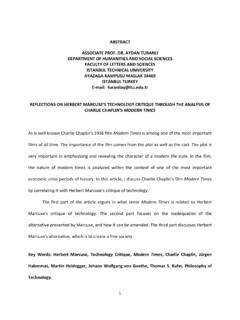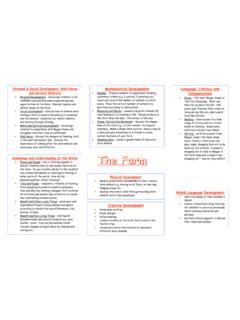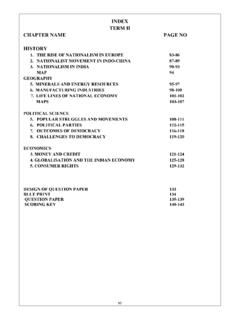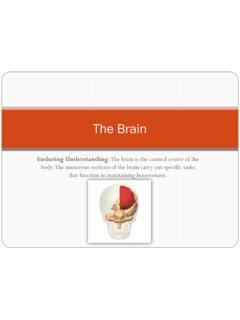Transcription of Teenagers with High Functioning Autism (HFA) & …
1 Teenagers with high Functioning Autism (HFA) & asperger s Disorder (AD) Going to school Dr Avril V. Brereton Monash University, Centre for Developmental Psychiatry and Psychology Autism Spectrum Disorder (ASD) is a group of conditions with social disability as the core feature. These conditions are now recognized as more common than previously believed. Recent research suggests that the rise in detected prevalence of ASD has been most pronounced among those without intellectual disability (Kim et al.)
2 2011; US CDC 2012). In Australia, Autism Spectrum Disorder (including Autistic Disorder, asperger s Disorder and high Functioning Autism ) is estimated to affect up to 1 in 160 (Wray and Williams, 2007). Although the presenting symptoms change with maturation, they continue to be a major source of difficulty for many. Most students with ASD find school challenging at some time or other. This can be the case no matter what the type of school; specialist or mainstream, primary or secondary. For those high Functioning students attending mainstream secondary school, the continuing challenges of ASD (difficulties with communication and social skills, emotional and behavioural difficulties) combined with the added demands of secondary school indicate that support needs are ongoing.
3 These young people are not growing out of their ASD, they are growing with it. Do we need to think about students having HFA or AD? Why not just call it ASD and treat them all the same? You are probably aware that the recent DSM-5 has removed the categories of asperger s Disorder and Autistic Disorder and incorporated them into the broader category of Autism Spectrum Disorder (ASD) (APA, 2013). *See Factsheet on DSM-5 and ASD for more information. According to the DSM-5 those who already have a DSM-IV diagnosis should be relabeled with ASD but services that have a requirement for regular review will require a reassessment according to DSM-5.
4 Individuals who have developed their identity and adjusted to having asperger s Disorder or high Functioning Autism may be confused and troubled by these changes and we do not know yet how this will work out for them and their families. So should we still even talk about HFA and AD? I would say yes, most definitely. The key to successfully teaching and working with a student with HFA or AD lies in having a good understanding of who they are, how they think and how their symptoms affect their daily life and learning.
5 Remember, students who have been given these diagnoses during childhood are now adolescents who regard their HFA and AD symptoms as being part of who they are. Below is a description of each of these disorders and their core features during childhood and adolescence. Autistic Disorder ( Autism ) American psychiatrist Dr. Leo Kanner introduced the word Autism , derived from the Greek word auto or self to the scientific community. Kanner first described the core features of Autism in his paper of 1943 in which eleven children with autistic disturbances of affective contact showed a distinctive and previously unreported pattern of symptoms that included an inability to relate to people and situations; failure to use language for the purpose of communication; obsessive desire for the maintenance of sameness in the environment (Kanner, 1943).
6 These three core symptoms have remained central to the diagnosis of Autism . Approximately 30% of persons with DSM-IV Autistic disorder ( Autism ) have overall cognitive abilities in the normal range and are referred to as high Functioning , but still usually have the pattern of a relatively wide scatter of abilities. 1. Social impairments Qualitatively impaired social interactions were the focus of Kanner s original clinical description of children with Autism (Kanner, 1943). A distinctive pattern of atypical social interactions remains a core feature of Autism .
7 Impairments in interpersonal relationships include a reduced responsiveness to or interest in people, an appearance of aloofness and a limited or impaired ability to relate to others. The child with Autism may not seek physical comfort, but attachment to their parents and caregivers is apparent. It is not simply the case that children with Autism do not develop social relating skills, it is more true to say that the quality of the relationship is abnormal. Children with Autism may show very little variation in facial expression in response to others, generally have abnormal eye contact and in early childhood they tend not to engage in social imitation such as waving bye-bye and pat-a-cake games.
8 They rarely develop an age-appropriate empathy or ability to understand that other people have feelings. Their ability to make friends is absent or distorted and they are usually unable to play reciprocally with other children. All children with Autism show social impairments, however, the nature of these impairments can vary and may modify as the child grows older. There may be an increase in interest in other people and the development of some social skills often learned in a mechanical or inflexible manner.
9 For example, a teenager may lurch toward a stranger who is walking past him to try and shake his hand because he has been taught to greet people with a hand shake. Adolescents with Autism usually have to learn about social skills and personality development without the opportunity of peer group discussion and support that is available to typically developing adolescents (Howlin, 2005). 2. Communication skills Impairments in both verbal and non-verbal communication skills are often the cause for parents of children with Autism to be first concerned and seek help (Howlin and Asgharian, 1999).
10 Children with Autism usually have markedly delayed and disordered speech with approximately half failing to develop functional speech. Children with Autism also have an impaired ability to use gesture and mime. In those children who develop functional language, the pattern of development and usage is strikingly odd. Tone, pitch and modulation of speech is often unusual and the voice may sound mechanical and flat in quality with a staccato delivery. Some speak in whispers or too loudly, sometimes developing an unusual accent.







